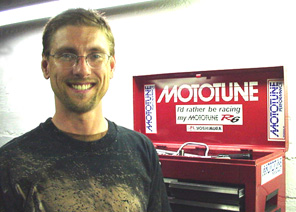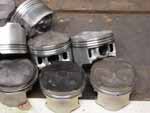
![]() .
.
" There are a lot of
myths about engines...
easy break-in is one of the biggest "

KNOWLEDGE
=
POWER !!
|
|
|
Warning:
This is a very controversial topic !!
I wrote "Break-In Secrets" after successfully applying
this method
to approximately 300 new engines, all without any problems whatsoever.
Links to this article now appear on hundreds of motorsports discussion forums
from all over the world. The reason is that over time, large numbers of people have done a direct comparison between my method and the owner's manual method, and the news of their success
is spreading rapidly.
The results are always the same... a dramatic increase in power at all RPMs. In
addition, many professional mechanics have disassembled engines that have used
this method, to find that the condition of the engine is much better than
when the owner's manual break-in method has been used.
The thing that makes this page so controversial is that there have been many other
break-in articles
written in the past which will contradict what has been written here.
Several factors make the older information on break-in obsolete.
The biggest factor is that engine manufacturers now use a much finer honing pattern
in the cylinders than they once did. This in turn changes the break-in
requirements, because as you're about to learn, the window of opportunity for
achieving an exceptional ring seal is much smaller with
newer engines than it was with the older "rough honed" engines.
In addition, there is a lot less heat build up in the cylinders from ring
friction
due to the finer honing pattern used in modern engines.
The other factors that have changed are the vastly improved metal casting and
machining
technologies which are now used. This means that the "wearing in" of the new
parts
involves significantly less friction and actual wear than it did in the distant past.
With that in mind ...
Welcome to one of the most controversial
motorsports pages on the internet !!
How To Break In Your Engine
For
More Power & Less Wear !
One of the most critical
parts of the engine building process is the break in !!
No matter how well an engine is assembled, it's final power output is all up to you
!!
Although the examples shown here are motorcycle
engines,
these principles apply to
all
4 stroke engines:
Street
or Race
Motorcycles, Cars, Snowmobiles, Airplanes & yes ...
even Lawn Mowers !!
( regardless of
brand, cooling type, or number of cylinders. )
These same break in techniques apply to both steel cylinders and Nikasil,
as well as the ceramic
composite cylinders that Yamaha uses in it's motorcycles and snowmobiles.
What's The Best Way To Break-In A New Engine ??
The Short Answer: Run it Hard !
|
Here's How To Break-In
An Engine Properly:
NOTE: If you use a
dyno with a brake, it's critical during break - in that you
allow the engine to decelerate fully on it's own. (Don't use the dyno brake.) The engine vacuum created
during closed throttle deceleration sucks the excess oil and metal off the cylinder walls.
On the Street: |
|
Yeah - But ...
Q: What is
the most common cause of engine problems ??? |
|
What about running it
in the garage ???
Recent Snowmobile Info: |
A Picture's Worth A Thousand Words:
|
|
|
|
It's up to you: |
|
Some have felt that the piston which was broken in hard in
the above photo is too clean to be true !!
"That piston is impossible, there must be some trick going on."
So, here I present: "The Impossible Piston Museum"
Here are 14 pistons from 14 different bikes, with several
manufacturers represented. Some are
from streetbikes and some from racebikes.
All of the engines had the correct jetting, the reason some have black carbon deposits is because they were run on "pump gas", which burns dark regardless of the jetting. Whereas the lighter ones were run on oxygenated race fuel, which gives a very light tan to gray color. (Many of the black-carboned pistons were from racebikes.)
Disclaimer:
Absolutely no photo altering or physical cleaning of the pistons is
allowed in the museum !!
We run a legit exhibit, and all the artifacts on display are 100% genuine.
Note:
The controversial piston in the above picture is the last one in the middle
row,
and it's indicated by the arrows.
You can take a closer look by clicking on the photos to see the full sized
versions:
 << << |
It looks like there are more than 14 pistons, because the area in the 3 photos overlap.
It's 3 segments of a panorama photo to give you multiple views of this
extraordinarily rare collection.
The pistons have been stacked for display purposes only, they aren't going back
into engines. Always be super careful
when handling pistons, as the aluminum is soft and very easily dented, causing
combustion leakage, and friction ... neither of which is good for power.
As in any museum, some of the specimens are better examples than others,
but the point is that none have any leakage past the top ring, because they were
all broken in
by the method described here !
The only impossible thing about these pistons ...
is that it's impossible to achieve this result with an easy break-in.
What about street bikes ???
|
This piston is from a 650 Honda
Hawk. The brown discoloration that extends up into the piston pin bore
is burnt oil from the extreme heat leaking past all
3 rings !! The uneven heat leakage was so bad, that it caused the cylinder to distort and become out of round, causing piston to cylinder scuffing in the tight part of the "oval" cylinder. |
|
|
Why would Honda recommend a break in method which
will
prevent the |
|
Q: What's
the third most common cause of engine problems ???
A: Not
changing the oil soon enough after the engine is first run !!
Change Your Oil Right Away !!
The best thing you can do for your engine is to change your oil and filter
after the first 20 miles. Most of the wearing in process happens
immediately, creating a lot of metal in the oil. Plus, the amount of
leftover machining chips and other crud left behind in the manufacturing
process is simply amazing !! You want to flush that stuff out before it
gets recycled and embedded in the transmission gears, and oil pump etc...
Why do the manufacturers recommend waiting until 600 miles to
flush out all the loose metal ???
This is a good question ...
3 more words on break-
in:
NO SYNTHETIC OIL !!
Use Valvoline, Halvoline, or similar 10 w 40 Petroleum Car Oil for at least
2 full days of hard racing or 1,500 miles of street riding / driving.
After that use your favorite brand of
oil.
Viewer Questions:
Q:
If break- in happens so quickly,
why do you recommend using petroleum break- in oil for 1500 miles ??
A: Because
while about 80% of the ring sealing takes place in the first hour of running the
engine,
the last 20% of the process takes a longer time. Street riding isn't a
controlled environment, so most of the mileage may
not be in "ring loading mode". Synthetic oil is so slippery that it
actually "arrests" the break in process before the rings can seal
completely. I've had a few customers who
switched to synthetic oil too soon, and the rings never sealed properly no
matter how hard they rode. Taking a new engine apart to re - ring it is the last
thing anyone wants to do, so I recommend a lot
of mileage before switching to
synthetic. It's really a "better safe than sorry" situation.
Q: My
bike comes with synthetic oil from the factory, what should I do ??
A: I recommend changing the factory installed synthetic oil back to petroleum for the break-in period.
Q: What about the main and rod
bearings, don't they break - in ??
A:
Actually, the operation of plain bearings
doesn't involve metal to metal contact !! The shiny spots on used
bearings are caused from their contact with the crankshaft journals during start up
after the engine has been sitting a while,
and the excess oil has drained off. This is the main reason for not revving up
the engine when it's first started.
The subject of plain bearings is one of the most mysterious aspects of engines,
and will be covered in a future issue
of Power News. In it, I'll reveal more information that fully explains
the non-contact phenomenon.
Q: Why change the oil at 20
miles ?? Doesn't the oil pick up
screen catch the aluminum bits ???
A:
It's true that the screen
stops the big pieces, but many areas of the engine aren't within the oil
filtration system. The oil that is splashed around will circulate metal debris
to the lubricated bearing surfaces. For example, transmission gears and their ball bearings are unprotected by the filtration system,
and even the cam chain makes a perfect "conveyer belt" to
bring metal debris up into the cylinder head !!
A close examination of a new engine will reveal lots of aluminum deposits on steel parts. This aluminum
coats and tightens
up the clearances of the parts, which creates a loss of power. Most of the time
I spend "blueprinting"
an engine is actually inspecting every part and "de-aluminizing"
them !!
I prefer to remove the oil pan and clean the aluminum bits out of a new engine out that
way, but a $20 oil change
is an easy and inexpensive way to flush the initial particles that come loose in the
first miles.
Q:
What about motorcycle V.S. car oils ???
A:
This is a topic all by itself !! It will be covered in a future issue of Power
News.
Q: Will this break - in method
cause my engine to wear out faster ???
A: No, in fact,
a poor ring seal will allow an
increase in the by products of combustion to contaminate the oil.
Acid contamination and oil consumption are the 2 reliability problems which are
the result of an
"owner's manual" or "magazine tech article" style easy
break-in.
By following the instructions on this page, you'll find that your
oil is cleaner and the engine will rev quicker.
Plus, you'll have much better torque and power
across the power range from the vastly improved ring seal.
Reliability and Power are 100% connected !!
Here's The New Page I
Mentioned !!
I really think you'll like it !!
Click Here:

| Here's another page on this site --
PhotoWorld of Synchronicity -- " PhotoWorld
Of Synchronicity ". In this photo gallery each of the pairs has a relation of meaning to each other, (some have several relations) -- thus the name "Synchronicity". A few are easier to see immediately, some take a lot more thinking, and a few are extremely hard to figure out. All have a logical / lateral thinking answer. There have only been a few correctly answered -- so, if you are up to the challenge, there is a good chance that you can solve some !! Even if you are not into lateral thinking puzzles, the photographs themselves are the most striking images I find while out with my camera, and I hope you like them for their artistic value alone. Thanks for checking out PhotoWorld of Synchronicity, and please send your comments and answers at the e-mail on the bottom of each photo page. Sincerely, Pat McGivern ~MotoMan |
|
Learn How to Do it Yourself:
Smaller Intake Ports Gain 7 % More Power
|